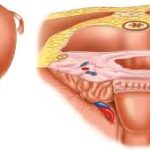Peptostreptococcus species are anaerobic, gram-positive cocci that form part of the normal flora of the mouth, gastrointestinal tract, and genitourinary system. While typically non-pathogenic in their natural environment, these bacteria can become opportunistic pathogens, particularly in anaerobic conditions associated with tissue necrosis or poor vascular supply. In osteomyelitis, their presence is rare but clinically significant.

Pathophysiology of Anaerobic Osteomyelitis
Osteomyelitis involving Peptostreptococcus spp. typically results from contiguous spread, such as from adjacent dental, sinus, or soft tissue infections. Hematogenous spread is less common in adults but may occur in pediatric cases. The anaerobic environment of necrotic bone and sequestra facilitates the proliferation of Peptostreptococcus, often in polymicrobial synergy with facultative or other anaerobic organisms.
Risk Factors
- Immunosuppression
- Diabetes mellitus
- Peripheral vascular disease
- Dental procedures or poor oral hygiene
- Post-traumatic or post-surgical bone exposure
- Chronic ulcers or pressure sores
Clinical Presentation and Symptomatology
Acute Osteomyelitis
- Localized bone pain and tenderness
- Fever and systemic signs of infection
- Swelling or erythema overlying affected bone
Chronic Osteomyelitis
- Recurrent or persistent drainage from a sinus tract
- Low-grade fever or malaise
- Radiographic evidence of bone destruction and sequestrum formation
Diagnostic Evaluation
Laboratory Investigations
- Complete Blood Count (CBC): Elevated WBCs in acute cases.
- Inflammatory Markers: C-reactive protein (CRP) and erythrocyte sedimentation rate (ESR) are typically raised.
- Blood Cultures: May be positive in hematogenous spread.
Microbiological Studies
- Anaerobic Culture Techniques: Critical for detecting Peptostreptococcus spp., requiring proper specimen handling and rapid transport in anaerobic conditions.
- Polymerase Chain Reaction (PCR): Useful in identifying bacterial DNA when cultures are negative.
Imaging Modalities
- X-Ray: Late findings; may show bone lysis, sclerosis, or periosteal reaction.
- MRI: Gold standard for early detection of marrow edema, abscess formation, and soft tissue involvement.
- CT Scan: Superior for detecting sequestra and cortical bone involvement.
Treatment Protocols for Peptostreptococcus Osteomyelitis
Antimicrobial Therapy
Empirical Coverage: Start broad-spectrum antibiotics with anaerobic coverage until cultures return.
Targeted Therapy: Once Peptostreptococcus is isolated, the following agents are typically effective:
- Penicillin G – First-line, if no resistance.
- Clindamycin – Excellent anaerobic coverage and bone penetration.
- Metronidazole – Effective against anaerobes but often used in combination.
- Beta-lactam/beta-lactamase inhibitors – e.g., amoxicillin-clavulanate or piperacillin-tazobactam.
Duration:
- Acute: 4–6 weeks of intravenous or highly bioavailable oral antibiotics.
- Chronic: May require ≥6 weeks of IV therapy followed by oral suppression.
Surgical Management
Surgery is often essential in chronic or unresponsive cases:
- Debridement of necrotic bone
- Drainage of abscesses or sinus tracts
- Sequestrectomy and possible bone grafting
- Amputation in severe, limb-threatening infections
Complications and Prognosis
Potential Complications
- Chronic infection and recurrence
- Pathologic fractures
- Fistula or sinus tract formation
- Septicemia and systemic spread
Prognosis
With early detection and appropriate surgical-antibiotic therapy, outcomes are generally favorable. Delayed diagnosis significantly increases the risk of chronicity and morbidity.
Preventive Measures and Follow-up
- Prompt Treatment of Soft Tissue Infections
- Oral Hygiene Maintenance for high-risk individuals
- Optimizing Glycemic Control in diabetic patients
- Regular Monitoring post-treatment with inflammatory markers and imaging
Peptostreptococcus osteomyelitis represents a diagnostic and therapeutic challenge due to its rarity and the need for anaerobic-specific protocols. Timely recognition, accurate microbiological diagnosis, and a multidisciplinary approach to treatment are essential in ensuring optimal patient outcomes.

